Having run trials of its PowerPay cashless RFID payment system at limited locations at two National Football League stadiums—the Seattle Seahawks’ Qwest Field and the Philadelphia Eagles’ Lincoln Financial Field—during the past football season, Smart System Technologies (SST) is now fully deploying its RFID payment system across both stadiums in time for next season.
The system works by linking PowerPay RFID readers to point-of-sale (POS) terminals. To make purchases, consumers can opt to use a personal PowerPay key fob fitted with an RFID tag. That tag carries a unique “license plate” number and no personal data. By putting the tag within an inch and a half of the reader the consumer can make the purchase. The company says it has initially targeted football stadiums for its payment system, but it says that is just the first part of a push to see its RFID payment systems installed throughout a range of arenas and retail outlets.
“Football is a good place for us to start. Football teams consistently sell out so they have to look for new ways to raise incremental revenues beyond selling seats,” says Michael Richardson, chief technology officer at SST, which is based in New York City. For SST, partnering with NFL teams to promote its cashless payments system to their fans creates a way to tie cashless payments into targeted marketing promotions. So far, promotional offers have allowed fans to enter sweepstakes and earn points for dollars spent with PowerPay that could be redeemed for merchandise and rewards.
SST is not the only company to see the potential of RFID to enable consumer purchases. In September 2003, Canadian start-up Dexit launched a similar electronic payment service in its home city of Toronto (see Dexit Turns RFID Cards into Cash), and several RFID-based payment services already exist in the U.S., including ExxonMobil’s popular Speedpass, used by customers at fuel pumps, and similar offerings by Philips 66 and Citgo. American Express has been testing its ExpressPay RFID payment product with merchants in the Phoenix area.
SST says it will install its RFID readers at all 401 point-of-sale terminals in concession and merchandise areas throughout Philadelphia’s Lincoln Financial Field. At Seattle’s Qwest Field, where 56 PowerPay readers were installed for the initial trial, SST will have its PowerPay system linked to all the stadium’s registers by the start of the NFL season.
The trials of the systems were held from the start of the season in Seattle and installed midway through last season in Philadelphia. According to SST, the system provides consumers and retailers alike with a faster way to complete transactions. For businesses, there is also the benefit of being able track customer transactions far better than through cash transactions.
During the two trial deployments, the average PowerPay transaction was more than twice as fast as cash and almost six times faster than a credit or debit card. In addition, consumers typically spent twice as much money using the PowerPay key fob as they did with credit cards or cash, says SST.
The company is currently using RFID readers from On Track Innovations, which is based in Rosh Pina, Israel, but SST maintains that in the future, it will buy its readers and tags from multiple vendors. The technology uses RFID that operates at 13.56 MHz and conforms to the ISO 14443 standard. The readers connect to serial ports already available on POS terminals although some software modifications have to be made to the POS terminal to offer the PowerPay option to customers.
To get a PowerPay tag and account, consumers can register online, either at the www.MyPowerPay.com Web site or at Web sites operated by the NFL teams, or they can call a toll-free number. There is no prepayment or subscription fee, but consumers have to register a credit card or check card to which PowerPay purchases can be billed. In the trials, Smart System said it saw a 35 percent take-up rate from consumers to whom the service was available.
As well as speeding sales, SST says, the PowerPay system also offers retailers a way to offer more targeted promotional and reward programs for their customers by linking frequent payments made on the card to savings and promotional gifts. SST maintains a consumer registry of PowerPay users, and provides line-item transaction detail merged with consumer information in aggregate to create custom profiles that can be used to create individual promotions based on a consumer’s preferences. SST keeps all the data relating to each customer. It will not, however, reveal an individual consumer’s information to a retailer, other than transaction information specific to that retailer, but says that the data it collects will be used to track broader purchasing behavior. Consumers are “identified” by their demographic, psychographic and purchase data, not by individual personal identity.
“We are confident that the technology can do for consumers what RFID is already doing for inventory and product ID. Instead of products, we identify consumers and have them control how that information is used,” says Richardson.
Within the PowerPay system, consumers can maintain their individual privacy and still be included in promotions and other offers based on their buying preferences, but the more data they supply about their likes and dislikes, the more relevant their offers will be based on the profile that is created for them, says SST.


